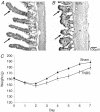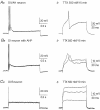Phenotypic changes of morphologically identified guinea-pig myenteric neurons following intestinal inflammation
- PMID: 17615102
- PMCID: PMC2277021
- DOI: 10.1113/jphysiol.2007.135947
Phenotypic changes of morphologically identified guinea-pig myenteric neurons following intestinal inflammation
Abstract
We investigated the responses of morphologically identified myenteric neurons of the guinea-pig ileum to inflammation that was induced by the intraluminal injection of trinitrobenzene sulphonate, 6 or 7 days previously. Electrophysiological properties were examined with intracellular microelectrodes using in vitro preparations from the inflamed or control ileum. The neurons were injected with marker dyes during recording and later they were recovered for morphological examination. A proportion of neurons with Dogiel type I morphology, 45% (32/71), from the inflamed ileum had a changed phenotype. These neurons exhibited an action potential with a tetrodotoxin-resistant component, and a prolonged after-hyperpolarizing potential followed the action potential. Of the other 39 Dogiel type I neurons, no changes were observed in 36 and 3 had increased excitability. The afterhyperpolarizing potential (AHP) in Dogiel type I neurons was blocked by the intermediate conductance, Ca(2+)-dependent K(+) channel blocker TRAM-34. Neurons which showed these phenotypic changes had anally directed axonal projections. Neither a tetrodotoxin-resistant action potential nor an AHP was seen in Dogiel type I neurons from control preparations. Dogiel type II neurons retained their distinguishing AH phenotype, including an inflection on the falling phase of the action potential, an AHP and, in over 90% of neurons, an absence of fast excitatory transmission. However, they became hyperexcitable and exhibited anodal break action potentials, which, unlike control Dogiel type II neurons, were not all blocked by the h current (I(h)) antagonist Cs(+). It is concluded that inflammation selectively affects different classes of myenteric neurons and causes specific changes in their electrophysiological properties.
Figures









Similar articles
-
Slow synaptic transmission in myenteric AH neurons from the inflamed guinea pig ileum.Am J Physiol Gastrointest Liver Physiol. 2009 Sep;297(3):G582-93. doi: 10.1152/ajpgi.00026.2009. Epub 2009 Jun 25. Am J Physiol Gastrointest Liver Physiol. 2009. PMID: 19556360
-
Correlation of morphology, electrophysiology and chemistry of neurons in the myenteric plexus of the guinea-pig distal colon.J Auton Nerv Syst. 1999 Apr 16;76(1):45-61. doi: 10.1016/s0165-1838(99)00008-9. J Auton Nerv Syst. 1999. PMID: 10323306
-
Correlation of electrophysiological and morphological characteristics of myenteric neurons of the duodenum in the guinea-pig.Neuroscience. 1998 Feb;82(3):899-914. doi: 10.1016/s0306-4522(97)00318-7. Neuroscience. 1998. PMID: 9483544
-
Consequences of intestinal inflammation on the enteric nervous system: neuronal activation induced by inflammatory mediators.Anat Rec. 2001 Jan 1;262(1):79-90. doi: 10.1002/1097-0185(20010101)262:1<79::AID-AR1013>3.0.CO;2-K. Anat Rec. 2001. PMID: 11146431 Review.
-
Species-dependent features of Dogiel type II neurones in the mammalian enteric nervous system.Eur J Morphol. 1999 Oct;37(4-5):241-9. doi: 10.1076/ejom.37.4.241.4730. Eur J Morphol. 1999. PMID: 10477469 Review.
Cited by
-
Structural changes in the epithelium of the small intestine and immune cell infiltration of enteric ganglia following acute mucosal damage and local inflammation.Virchows Arch. 2009 Jul;455(1):55-65. doi: 10.1007/s00428-009-0795-x. Epub 2009 Jun 11. Virchows Arch. 2009. PMID: 19517133
-
Inhibition of APE1/Ref-1 Redox Signaling Alleviates Intestinal Dysfunction and Damage to Myenteric Neurons in a Mouse Model of Spontaneous Chronic Colitis.Inflamm Bowel Dis. 2021 Feb 16;27(3):388-406. doi: 10.1093/ibd/izaa161. Inflamm Bowel Dis. 2021. PMID: 32618996 Free PMC article.
-
Effects of Oxaliplatin Treatment on the Enteric Glial Cells and Neurons in the Mouse Ileum.J Histochem Cytochem. 2016 Sep;64(9):530-45. doi: 10.1369/0022155416656842. Epub 2016 Jul 7. J Histochem Cytochem. 2016. PMID: 27389702 Free PMC article.
-
An objective in vivo diagnostic method for inflammatory bowel disease.R Soc Open Sci. 2018 Mar 21;5(3):180107. doi: 10.1098/rsos.180107. eCollection 2018 Mar. R Soc Open Sci. 2018. PMID: 29657828 Free PMC article.
-
Neuroprotective Potential of Mesenchymal Stem Cell-Based Therapy in Acute Stages of TNBS-Induced Colitis in Guinea-Pigs.PLoS One. 2015 Sep 23;10(9):e0139023. doi: 10.1371/journal.pone.0139023. eCollection 2015. PLoS One. 2015. PMID: 26397368 Free PMC article.
References
-
- Beyak MJ, Ramji N, Krol KM, Kawaja MD, Vanner SJ. Two TTX-resistant Na+ currents in mouse colonic dorsal root ganglia neurons and their role in colitis-induced hyperexcitability. Am J Physiol Gastrointest Liver Physiol. 2004;287:G845–G855. - PubMed
-
- Bielefeldt K, Ozaki N, Gebhart GF. Mild gastritis alters voltage-sensitive sodium currents in gastric sensory neurons in rats. Gastroenterology. 2002;122:752–761. - PubMed
-
- Black JA, Liu S, Tanaka M, Cummins TR, Waxman SG. Changes in the expression of tetrodotoxin-sensitive sodium channels within dorsal root ganglia neurons in inflammatory pain. Pain. 2004;108:237–247. - PubMed
-
- Brehmer A, Schrodl F, Neuhuber W. Morphological classifications of enteric neurons – 100 years after Dogiel. Anat Embryol. 1999;200:125–135. - PubMed
-
- Brookes SJH. Classes of enteric nerve cells in the guinea-pig small intestine. Anat Rec. 2001;262:58–70. - PubMed
Publication types
MeSH terms
Substances
LinkOut - more resources
Full Text Sources
Miscellaneous

